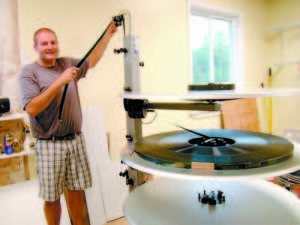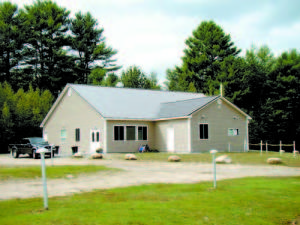Drive-In feels push to digital

LAST SUMMER FOR FILM — Bridgton Twin Drive-In owner John Tevanian holds film for two movies, Planes and Ironman 3, resting on a platter Friday, ready to be wound into a projector for the weekend showing. When he acquired the three-tray platter system last year, it didn’t cost him a dime, because 35-millimeter film is being discontinued by the movie industry in favor of digital projection systems. Although film prints of first-run movies were in short supply this summer, “We had no problem playing all the first-run movies we wanted to play this summer,†Tevanian said. He’s also confident film will be around next year, but he has seen the handwriting on the wall, and will be converting to digital. (Geraghty Photo)
By Gail Geraghty
Staff Writer
John Tevanian just shakes his head and smiles when people ask him how he was able to get 35 millimeter film prints of first-run movies this summer to keep his Bridgton Twin Drive-In Theater going.
Aren’t all the Hollywood movie studios getting rid of film? How could he survive without converting to digital projectors?
“We had no problem playing all the first run movies we wanted to play this summer,†said Tevanian, who took over the 57-year-old drive-in in 1996 from his father (also John Tevanian). “Any drive-ins that claim otherwise on their Facebook page are just talking.â€
With 85 to 90% of the country’s movie theaters having already converted to digital technology, there are, of course, fewer 35-mm film prints being made, he said. But they’re out there, if you know where to look and don’t give in to all the “horror stories†saying the digital revolution is forcing the few remaining drive-ins in the U.S. (around 400, down from 4,000 at the peak) to close.
Still, it was at times challenging this summer for Tevanian to snag a film print of a new release, which is why he will be converting to digital projectors next summer. When Riddick “opened wide†and was released to around 6,000 movie screens Sept. 6, he said there were only 85 film prints made in the entire country.
And only three theaters in New England had a copy. Tevanian kept calling them, and his persistence paid off; one of the theaters passed the movie along to him after they’d had it for a two-week run.
“It is getting to a point that if you want to make sure you can get everything in a timely fashion, you have to have it (a digital projection system).â€
Tevanian talks to the studios almost daily, and he was confident going into this summer that film would still be around this year, and even next year. Despite the widely-held notion that the studios plan to discontinue film at the end of the year, he said, there’s been no official announcement from any studio to the United Drive-In Theatre Owners Association of a “drop-dead†date for film prints, he said. He notes that most of the major studios hold multi-year prepaid contracts with Kodak, the sole manufacturer of 35-mm movie prints — and therefore have a commitment and financial interest in continuing to produce something they’ve already paid for.
And although the vast majority of the U.S. and European movie exhibitors have converted to digital, that’s not the case in other countries, particularly South America, where the market for film will continue for years to come, he said.

ALL IN — Bridgton Twin Drive-In owner John Tevanian spared no expense in replacing his worn-out concession stand with this new building, completed this summer. At roughly triple the size, with a takeout window and projection room in front, the year round building cost Tevanian around $350,000, and was built to specs to accommodate a digital projector, which requires special glass, more vents, stronger air-conditioning and an Internet connection. With two digital projectors at around $70,000 each, Tevanian’s total investment adds up to around $500,000. With digital film an inevitability, he said, “I decided I was either all in, or all out.†(Geraghty Photo)
“For all us small-time exhibitors, we knew (digital) was coming. This ticking time bomb has been around for 10 or 15 years,†said Tevanian. That’s when the studios began enticing the big indoor movie chains like Regal to convert from film by offering them a digital print rebate each time they showed a digital movie. The rebates were funded by the nearly $1,300 that they saved on manufacturing and shipping each 50–75 pound reel of film.
The financing plan was a godsend for smaller theaters like Bridgton’s other movie exhibitor, the Magic Lantern Movie Theatre, which got in on the end of the program when it bought three digital projectors for its three screens last year. In five years, the program will allow the Magic Lantern to recapture 80% of their $200,000 investment (see sidebar, this page).
Going digital not only allows the studios to save big on film manufacturing, it gives them the ability to distribute their movies on several different platforms, he said.
“You can't blame them, but (movie studios) would like to get rid of the middleman, basically. They want to go direct to the consumer. That way, they can keep all of the profits instead of sharing some of it with the exhibitors,†said Tevanian. “But they also know that the exhibition business is the best advertising tool for their DVD sales, so they do like us.â€
The reality is, however, that the studios only are really listening to the big movie theater chains, he said. And all of those businesses have already converted, for the most part.
“(The studios) have already got enough saturation now, so they could care less about the little theaters like the Bridgton Drive-In. The theaters that have not converted yet are on the low end of the pole anyway†of the around 400 drive-ins left in the country,
The drive-ins are not being offered any rebate plan by the studios to help them recoup their investment. That’s why this summer Honda started their online Project Drive-In contest, to buy digital projectors for up to nine drive-ins in the country in order to “preserve this iconic part of American car culture.†Fans may vote or text once a day for the drive-in of their choice, and winners are chosen based on voting totals.
Honda announced last week that the Saco Drive-In, which opened in 1939 and is the second oldest drive-in in the country, was the first winner in the contest. The Pride’s Corner Drive-In, owned by his father, is also participating in the contest. Although Tevanian was invited by Honda to participate, he decided to pass.
“We are a for-profit business,†he explained. “I have a hard time asking anyone for anything.†And even if the big movie studios don’t care about the future of the Bridgton Drive-In, Tevanian surely does.
He grew up in the business, after all, after his father purchased the Bridgton Drive-In in 1971. Ever since he began leasing it on his own in 1996, he’s thought ahead, and the digital conversion is no exception. “I went into this knowing full well that I expected it to be a loss, so knowing that going in, if it is a loss, so what.â€
When Tevanian added a second 70-foot screen in 2000, raising the capacity to 450 cars, it proved to be a good decision; by the second year business had increased by 50% and the next three years proved to be his peak years.
Business went up from 1996 to 2002, then went up and down, and now it’s leveled out, he said, although business is still far superior to what it was in the 1980s. “When I went off to college in 1986, I would’ve bet you anything that this theater would have been gone,†he said.
With the digital conversion looming, Tevanian had a decision to make. His infrastructure badly needed a facelift, especially the concession stand, if it was going to make any sense to invest $70,000 apiece for two digital projectors.
So he took the plunge last year, investing around $350,000 to triple the size of his concession building with a state-of-the-art kitchen, large modern restrooms and a projection room designed to meet the exacting climate-control specs of drive-in digital projectors. When his two digital screens open next summer, he’ll have made perhaps a $500,000 investment.
“There is nothing, absolutely nothing, that makes this work,†Tevanian said. “Nothing. It just doesn't work financially. I'm just doing it. The money I'm investing, I'd be better off investing it in stocks. You'd get much better return than anything I could possibly do here. And a lot less risk.â€
But Tevanian is one of those people who measures his rewards more broadly than by simple financial terms. “I grew up with this theater, and if you talk to some of the employees in the summer, absolutely, I bitch and moan — but at the end of the day, I love the business.â€
He’s seen the digital drive-in technology in place in Mansfield, Conn., and is confident his customers will notice a marked improvement in brightness and sharpness of the picture. The heat generated by the powerful 7,000-watt bulbs required to throw the image the length of a football field can tend to buckle film, producing areas of uneven focus. With digital projection, he said, “You can zoom in on every area to make it even. Each individual area can be really refined†so the light is evenly distributed, and there’s no “cone†effect.
Going digital will also allow him to show old movies, which are too scarce and expensive now for drive-ins to show as 35 mm film prints. Tevanian hopes to replicate other digital drive-ins’ trend toward having “Retro Nights†during the weekdays when business is slower.
“I decided going into this that I was going to be either all in or all out. Well, I’m all in.â€

